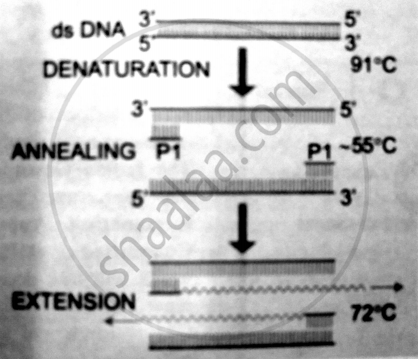Advertisements
Advertisements
प्रश्न
What does PCR stand for? Describe the different steps of PCR
उत्तर
PCR stands for Polymerase Chain Reaction:
Basic requirements for PCR technique are :
1) A DNA segment (100-35, 000 bp in length) be amplified.
2) Primers (forward and reverse) which are synthetic oligonucleotides of 17-30 nucleotide. They
are complementary to the sequence present on the desired DNA segment.
3) Four types of deoxyribonucleotides (dATP, dCTP, dGTP, dTTP). They are collectively called
dNTPs
4)A thermostable DNA polymerase, that can withstand up to 94°C. Usually, Taq polymerase isolated from bacterium Thermus aquaticus is used.

The three essential steps for PCR technique are :
1) Heat denaturation: This step involves heating of DNA at about 91°C. The heating breaks the hydrogen bonds to make ssDNA. The DNA molecule with more G-C pairs needs the higher
temperature.
2)Annealing: It is pairing of primers to the ssDNA segment. The primer has to be designed as per the requirement. this step requires temperature at about 55°C.
3) Polymerisation: The temperature is raised to 72°C. The Taq polymerase adds dNTPs behind
the primer on the ssDNA
These three steps constitute one cycle of the reaction. The process is carried out for about 28-30 cycles beyond which its reliability decreases.
APPEARS IN
संबंधित प्रश्न
State the role of DNA ligase in biotechnology.
Write a short note on Electrophoresis.
Bt-cotton shows adverse effect on the population of which butterfly?
The main reason for the presence of both a leading and a lagging strand during DNA replication is, ______
The rDNA technology has provided a method to control the nematode parasite Meloidogyne incognita. Explain the principle involved in this technique.
Annealing step of PCR operates at ______ °C.
Name two restriction enzymes used in PCR.
Study the following lists and choose the correct match.
| List I | List II |
| A. Vector | (i) Resistant to cotton bollworms |
| B. Downstream processing | (ii) Mobile genetic elements |
| C. Cry II AB | (iii) Controls corn borers |
| D. Transposons | (iv) Ti plasmid |
| (v) Purifying protein in biopharmaceuticals |
Give a reason for the following:
DNA cannot enter directly into the host cell.
State the steps involved in the process of gene therapy for the treatment of ADA-deficiency.
